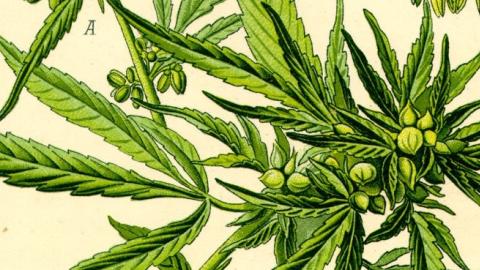A shortened version of this article was published in Real Clear Education on May 18, 2015.
The dose makes the poison.
-Paracelsus
According to a new Pew survey, political support for legalizing marijuana is strongest among the generation known as the millennials (those born after 1980). Pew’s survey showed fully 68 percent of them want legal dope (in contrast, only 29 percent of the “Silent Generation”—born between 1928 and 1945—support legal marijuana). By this political support, millennials may be paving their own pathway to a problematic educational future.
The impact of high-potency marijuana use on American educational achievement, competitiveness, and even military readiness has been overlooked, if not dismissed. Yet there are serious reasons for concern.
While marijuana use has long been a variable affecting school performance, education and health research has neglected evidence that a substantial increase in marijuana potency over the past twenty years is today producing much greater harm.
The concentration of the intoxicant THC found in marijuana has climbed from roughly 3–4 percent in the 1980s to the 20–30 percent common in current commercial products, with newer forms of the drug (such as “shatter”) reaching 70–80 percent THC, according to nationwide drug seizures. This increased potency ratchets up the damage to educational performance.
Recent research has not only made associations with psychotic effects on susceptible individuals, but has also stressed associations with diminished IQ and cognitive performance with heavy use and even detected brain abnormalities in association with “casual” exposure.
It is not farfetched to worry about marijuana use in intellectual endeavors. The National Institute on Drug Abuse (NIDA) reports that the use of marijuana, even mid-potency marijuana, affects educational performance because it “interferes with attention, motivation, memory, and learning,” and that students who are regular users “tend to get lower grades and are more likely to drop out.” NIDA concludes that youth using marijuana “may be functioning at a reduced intellectual level most or all of the time.”
It looks increasingly likely that early marijuana use is a causal variable in declining intellectual capacity. Moreover, whatever correlations we find between exposure to THC and cognitive and behavioral deficiencies in youth will likely accelerate as marijuana is legalized.
There are new data that bear on the matter, as the Educational Testing Service (ETS) reports on results from the Programme for International Assessment of Adult Competencies. When compared to their international counterparts in twenty-four advanced industrial nations, American students, specifically the millennial generation (between sixteen and thirty-four years of age at time of assessment) continued to score at or near the bottom in literacy, math, and even the “ability to follow directions” or perform technological problem-solving, despite having more years of schooling than their predecessors.
Education experts respond with reasonable explanations, such as America’s diversity or income inequality, coupled with weakened schools. But this time the “report card” from ETS is more complex, and suggests an additional cause for concern.
First, ETS notes that the performance of millennials in comparison to international peers is even lower than that of previous generations of Americans; that is, they look like America’s “weakest generation” cognitively. Second, when ETS compared only the elite (90th percentile), native-born school performers across the international setting, Americans fared still worse. Intense marijuana use is found among U.S. youth in every social stratum. Failing schools cannot fully explain the matter.
Not only do the ETS findings not augur well for academic achievement, but the impact may extend beyond schooling. Only 29 percent of youth of age for military service were deemed eligible for enlistment, with fully one-quarter failing the army’s basic math and reading test.
The measurable effect of marijuana use on millennials reflects the fact that as their brains were developing, they were exposed to THC the potency of which would today be considered mid-level. (As adolescents, they faced pre-2000 levels of THC potency, likely 10–15 percent even for the “premium” product.) In short, it is likely that there is worse to come.
How widespread is marijuana use in this generation? According to Monitoring the Future (MTF, an annual school survey conducted for NIDA, in 2014, more than 44 percent of high school seniors reported “Lifetime use” of marijuana, while more than 21 percent reported “Current use.” These figures have held roughly steady for several years, but the potency of the THC to which they are exposed and the intensity of use have increased dramatically.
When one in five high school youth are regularly using a substance known to impair cognitive performance, at stronger and stronger dose levels and increasingly with a pattern of daily consumption, the impact could well be sufficient to change society.
A common finding in studies of youth marijuana users is increased risk of dropping out of school. In a recent Lancet analysis, daily use of marijuana by adolescents increased their risk of dropping out of high school by 66 percent.
The school dropout problem affects all socio-economic groups, but it is devastating for the vulnerable. As a report by the Brookings Institution’s Hamilton Project showed, in the most recent birth cohort, 53 percentage points separate white from African-American male dropouts. And the school dropout problem for African Americans is linked to a 70 percent increased cumulative risk for imprisonment. In twenty states, African-American male high school graduation rates are below 60 percent.
There is no need to claim that minorities have higher rates of drug use (although there is some evidence for this), but rather that the impact is greater on those already facing disadvantage.
And what of Colorado, at the forefront of marijuana commercialization, which exploded in January of 2014? We already know that nationally, daily use of marijuana among those twelve and older shot up from 4.8 percent in 2002 to 8.1 percent by 2013. In 2011, with a permissive marijuana environment prior to commercialization, Colorado experienced daily use rates that were 35 percent higher than the national average. The full impact of commercialization in Colorado has not yet been measured.
But drug-related school disruption is clearly climbing. According to a recent report from the Colorado Department of Education, the percentage of expulsions for drug violations exploded from 26.2 percent to 41.9 percent between 2008 and 2014. (Overall suspensions/expulsions soared from 3,779 to 5,249 for drug-use violations). Again, these were measured prior to full commercialization.
Thus far, marijuana use has not been proven to be the master variable driving poor educational performance. Factors such as poverty, fatherlessness, or budgets no doubt play a role. Now, however, the failings can be seen in terms relative to earlier generations of Americans.
Policy experts have reached for explanations, even turning to possible environmental factors, such as exposure to chemicals like phthalates, which are used in plastics and have been linked to IQ loss. A study involving zebra fish (and not human adolescents) recently received front-section attention in the Washington Post. Yet the Post has been silent regarding the environmental effects of THC. This neglect is inexplicable.
To sum up, our argument is not that marijuana is necessarily the most important variable driving decline, though the evidence for a major role is compelling. We do argue, however, that the role of marijuana is the most neglected educational question of our time.




















